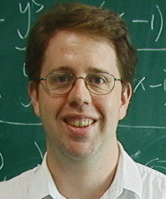Rice mathematicians win $1.7 million NSF research training grant
The future of research mathematics at Rice University is shaping up, thanks to a new $1.7 million National Science Foundation (NSF) grant to establish training programs for undergraduates, graduate students and postdoctoral researchers studying geometric problems.
“Our goal is to train the next generation of mathematicians and expose them to what it’s like to do mathematics at a high level,” said Brendan Hassett, professor and chair of Rice’s Department of Mathematics and the principal investigator on the new grant. “We’re focusing on undergraduate students who are considering a career in math, and we’re helping them develop the writing and the analytical skills they’ll need to be admitted to a top-tier graduate program.”

Rice has won a five-year $1.7 million research training grant from the National Science Foundation to help prepare the next generation of mathematics researchers.
Hassett said the five-year grant from the NSF’s Division of Mathematical Sciences will fund seminars, contests and other events, as well as stipends for postdoctoral instructors, graduate students, and undergraduate trainees.
The program is led by the Rice Geometry Group, which includes Hassett and four other Rice mathematicians — Tim Cochran, David Damanik, Robert Hardt and Michael Wolf — who are co-principal investigators on the grant.
“You can think of geometry as the lingua franca of this program,” Hassett said. “If you look at the hard technical things that the five of us do, they are very different. But geometry is the common ground. It’s where specialists meet to exchange ideas and techniques.”
Hassett said geometric problems have stimulated progress in most fields of mathematics for centuries. For example, the study of conic sections initiated by the ancient Greeks spurred the development of coordinate systems and polynomial algebra in the 17th century. The development of calculus was motivated by the desire to find curves and surfaces minimizing the energy of physical systems. More recently, geometric questions about knots and links have led to numerous advances in modern algebra.
Hassett said students must be firmly grounded in the basics to understand the latest research in modern fields like low-dimensional topology, Teichmueller theory, geometric measure theory and complex geometry. Moreover, students need training to adequately communicate their own ideas to their peers.
“Good written and oral communication skills have become more important as mathematics has gotten more complex and fragmented,” Hassett said. “You can’t expect people to read a 70-page paper simply because it’s correct. You need to find ways of making people quickly get an intuitive understanding of what you’re doing before they invest the hours and hours required to actually read all the details.”
Hassett said undergraduate and graduate students will participate in training seminars designed to hone their written and oral communications skills. Postdoctoral fellows will help teach the seminars and will assist faculty in working with undergraduates on independent research projects.
“The research component is designed to give the students exposure to topics in a given field and to give the faculty member an opportunity to know the students better and see how they engage with high-level questions in the field,” Hassett said. “That kind of experience is what most top graduate schools look for, and where Rice can really stand apart from other schools.”



It’s nice to know that there’s still funding available for traditional theoretical research. From today’s headlines it’s easy to get the idea that applied biology is the only important science, kind of like physics in the 1950s and 60s.